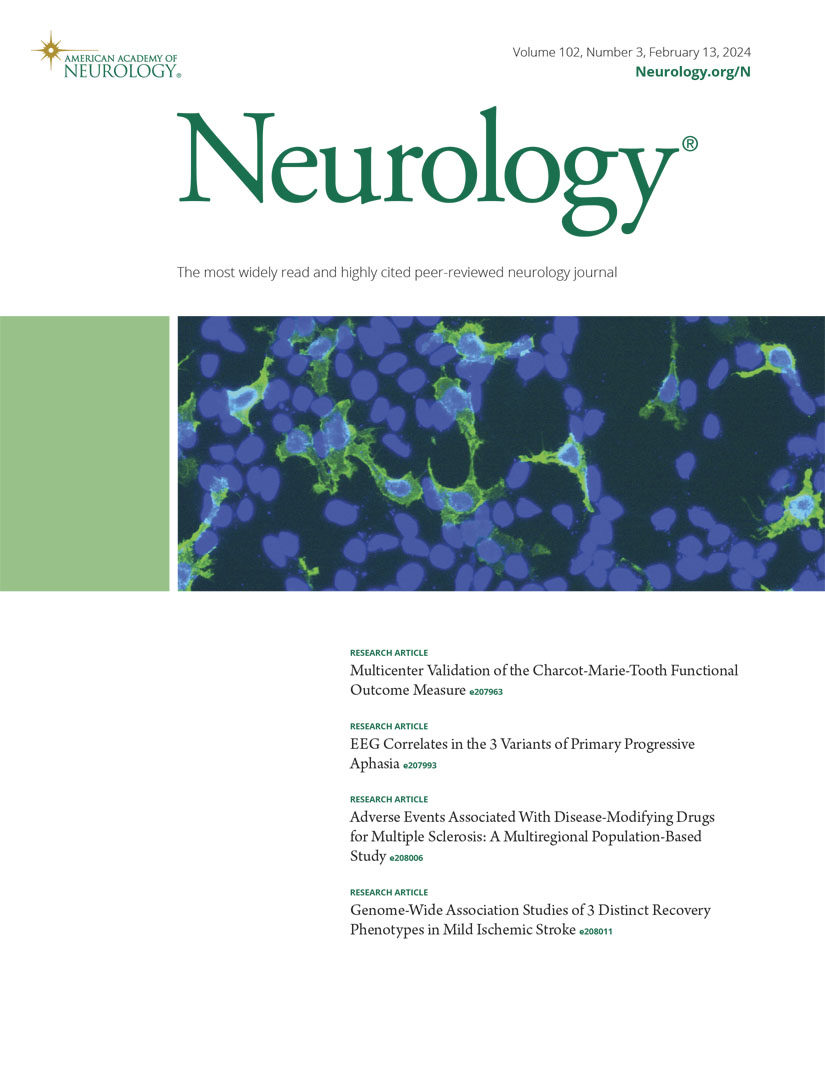Trends in Prenatal Exposure to Antiseizure Medications Over the Past Decade: A Nationwide Study.
IF 7.7
1区 医学
Q1 CLINICAL NEUROLOGY
引用次数: 0
Abstract
BACKGROUND AND OBJECTIVES Prenatal exposure to certain antiseizure medications (ASMs) is associated with established or suspected risks of congenital malformations and neurodevelopmental disorders. Large-scale, real-life data are essential to guide efforts to mitigate these risks. Our objective was to assess trends in prenatal exposure to ASMs over the past decade according to medication safety profiles. METHODS This nationwide, population-based study is based on comprehensive data of the French National Mother-Child Register EPI-MERES. All ASM-exposed pregnancies ended between 2013 and 2021 were included. ASM-exposed pregnancies' frequency and characteristics (maternal sociodemographics and morbidities, pregnancy outcome, and ASM treatment modalities) were assessed considering 3 safety categories: (1) ASMs considered the safest (lamotrigine and levetiracetam); (2) ASMs with uncertain risk, including pregabalin, gabapentin, and newer ASMs (e.g., lacosamide and zonisamide); and (3) ASMs with acknowledged risk, including valproic acid, valpromide, carbamazepine, and topiramate. RESULTS Between 2013 and 2021, 55,801 pregnancies were exposed to ≥1 ASM. Pregnancies exposed to the safest ASMs increased by +30%. Meanwhile, prenatal exposure to valproic acid and valpromide dramatically decreased due to decreasing numbers of exposed pregnancies (-84% and -89%, respectively), increasing termination rate of exposed pregnancies (+23% and +28%, respectively), and among those ended in childbirth, decreasing numbers with multiple valproate dispensations (-86% and -93%, respectively) or sustained exposure throughout pregnancy (-91% and -96%, respectively). Prenatal exposure to carbamazepine and topiramate barely decreased, with almost 600 newborns still exposed to each of these ASMs in 2019-2021. Pregabalin and gabapentin became widely used during pregnancy, resulting in more and more newborns prenatally exposed (+28%), and for pregabalin increasingly with multiple dispensations (+65%) and sustained exposure throughout pregnancy (+171%). The numbers of pregnancies and newborns exposed to newer ASMs also sharply increased (+140% and +60%, respectively). Overall, prenatal exposure to ASMs with acknowledged or uncertain risk disproportionately concerned pregnant women with a low level of resources (18.5% and 17.9%, respectively, vs 13%-14% among pregnancies exposed to the safest ASMs or ASM-unexposed). DISCUSSION Despite a sharp shift from valproate to safer ASMs, prenatal exposure to other ASMs with acknowledged or uncertain risks has persisted or even increased, particularly among the most socially disadvantaged populations, requiring additional risk minimization measures.过去十年产前抗癫痫药物暴露趋势:一项全国性研究。
背景和目的产前暴露于某些抗癫痫药物(asm)与已确定或疑似的先天性畸形和神经发育障碍风险相关。大规模、真实的数据对于指导减轻这些风险的工作至关重要。我们的目的是根据药物安全概况来评估过去十年中产前暴露于asm的趋势。方法:这项全国性的、以人群为基础的研究是基于法国国家母婴登记EPI-MERES的综合数据。所有在2013年至2021年期间结束的暴露于asm的妊娠都包括在内。评估ASM暴露妊娠的频率和特征(产妇社会人口统计学和发病率、妊娠结局和ASM治疗方式),考虑3种安全性类别:(1)ASM被认为是最安全的(拉莫三嗪和左乙拉西坦);(2)风险不确定的asm,包括普瑞巴林、加巴喷丁和较新的asm(如lacosamide和zonisamide);(3)具有公认风险的asm,包括丙戊酸、丙丙酰胺、卡马西平和托吡酯。结果2013年至2021年间,55801例妊娠暴露于≥1例ASM。使用最安全的asm的孕妇增加了30%。与此同时,产前暴露于丙戊酸和丙丙酰胺的孕妇数量减少(分别为-84%和-89%),暴露于丙戊酸和丙丙酰胺的妊娠终止率增加(分别为+23%和+28%),而在分娩结束的孕妇中,多次服用丙戊酸和丙戊酸的人数减少(分别为-86%和-93%)或妊娠期间持续暴露于丙戊酸和丙丙酰胺的人数减少(分别为-91%和-96%)。卡马西平和托吡酯的产前暴露率几乎没有下降,2019-2021年仍有近600名新生儿暴露于这两种asm。普瑞巴林和加巴喷丁在怀孕期间被广泛使用,导致越来越多的新生儿在产前暴露(+28%),普瑞巴林越来越多地被多次配药(+65%),并在整个怀孕期间持续暴露(+171%)。孕妇和新生儿暴露于新asm的人数也急剧增加(分别为+140%和+60%)。总体而言,产前暴露于已知风险或不确定风险的asm中,资源水平低的孕妇比例不成比例(分别为18.5%和17.9%,而暴露于最安全asm或未暴露asm的孕妇比例为13%-14%)。尽管从丙戊酸盐到更安全的asm的急剧转变,但产前暴露于其他已知或不确定风险的asm仍然存在甚至增加,特别是在最社会弱势人群中,需要额外的风险最小化措施。
本文章由计算机程序翻译,如有差异,请以英文原文为准。
求助全文
约1分钟内获得全文
求助全文
来源期刊

Neurology
医学-临床神经学
CiteScore
12.20
自引率
4.00%
发文量
1973
审稿时长
2-3 weeks
期刊介绍:
Neurology, the official journal of the American Academy of Neurology, aspires to be the premier peer-reviewed journal for clinical neurology research. Its mission is to publish exceptional peer-reviewed original research articles, editorials, and reviews to improve patient care, education, clinical research, and professionalism in neurology.
As the leading clinical neurology journal worldwide, Neurology targets physicians specializing in nervous system diseases and conditions. It aims to advance the field by presenting new basic and clinical research that influences neurological practice. The journal is a leading source of cutting-edge, peer-reviewed information for the neurology community worldwide. Editorial content includes Research, Clinical/Scientific Notes, Views, Historical Neurology, NeuroImages, Humanities, Letters, and position papers from the American Academy of Neurology. The online version is considered the definitive version, encompassing all available content.
Neurology is indexed in prestigious databases such as MEDLINE/PubMed, Embase, Scopus, Biological Abstracts®, PsycINFO®, Current Contents®, Web of Science®, CrossRef, and Google Scholar.
 求助内容:
求助内容: 应助结果提醒方式:
应助结果提醒方式:


